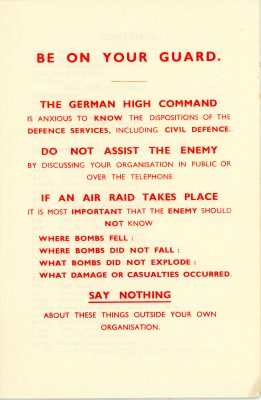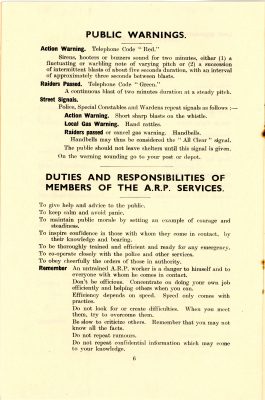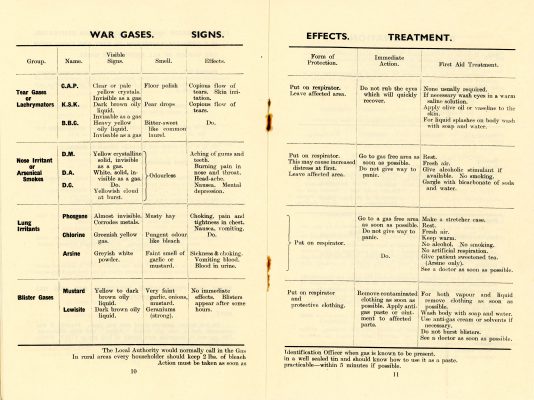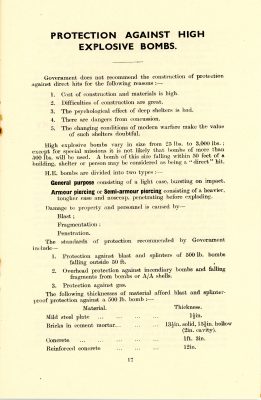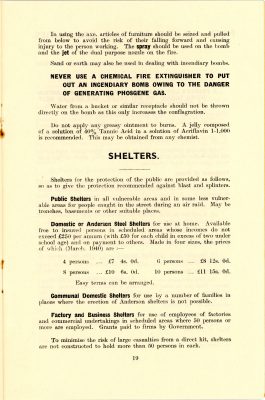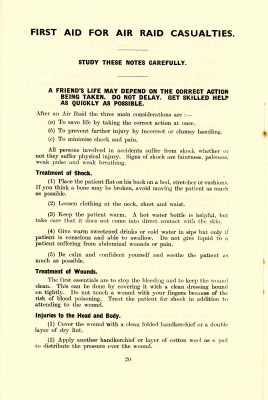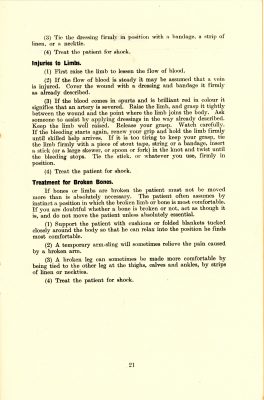Bombing of Blyth information pamphlets
Reference: NRO 10442/4
Suggested age groups: KS2, KS3, KS4, Lifelong Learners
Subject areas: WW2, Air Raids, Bombing of Blyth
CONTEXT
During the Second World War, Blyth Town Council printed this pamphlet for Air Raid Precaution (ARP) wardens.
It starts with a page in bold red writing, telling ARP wardens not to give information to the enemy. The index on the next page also includes a glossary of abbreviations that might be useful to a warden.
The “Public Warnings” section describes the different alarms used in an air raid and their meanings. The pamphlet then goes on to list the duties of the ARP warden (…Keep calm and avoid panic…”) and the different sorts of jobs ARP warden might be expected to do (….First Aid Parties, Rescue Parties…)
Next follows a section over several pages about gas. The different types of gas are explained, as are respirators (gas masks) and protective clothing (and how to undress from them). The middle pages of the pamphlet contain a table of the different types of gas and how someone who had been gassed should be treated.
Different types of bombs and shelters follows and the pamphlet ends with a summary of first aid treatments.
It is possible to see where the pamphlet was stapled together. It is very common for staples to rust and discolour the paper they are attached to. Most archives will remove staples from documents when are preserved.
ACTIVITIES
ACTIVITY 1
Background
During the Second World War, Blyth Town Council printed this pamphlet for Air Raid Precaution (ARP) wardens.
SEE
See: Who printed the pamphlet?
See: Who is the target audience of the pamphlet?
See: What is the purpose of the pamphlet?
THINK
Think: Why do you think this pamphlet was printed?
Think: Why do you think the information was circulated in pamphlet format? Is this the best format or can you think of other ways the information could have been shared?
Think: Look at the first page of the pamphlet. What does this tell you about British attitudes towards Germany?
Think: Why would the British not want the Germans to know where bombs did or did not fall or explode?
Think: What type of effect do you think this pamphlet had on the reader?
Think: Do you think this pamphlet is an example of propaganda?
DO
Do: Look at the first page of the pamphlet. Make a list of the different linguistic devices used.
Do: Write one sentence summarising what the first page tells you.
Do: Create a poster aimed at the public to visualise the information written on the first page.
Do: Write a script for a radio infomercial to get across the message of the first page of the pamphlet.
Do: Write a statement arguing either for or against using radio as a means of sharing wartime information. If you are against radio, how could you share your infomercial?
Do: In groups, debate whether or not you think this pamphlet is an example of propaganda, using the first page as evidence.
Do: Imagine you are in the Luftwaffe (German war time air force). Make a list of the reasons why you would want to know where your bombs fell.
Do: Look at a map of Blyth. Annotate the natural, industrial and manmade features that led to it being an air raid target.
Do: Write a diary entry from the perspective of a serviceman in the Luftwaffe sent to carry out an air raid strike against Blyth. Describe what they may have seen as they flew towards Blyth and how they may have felt.
Do: Research British air raid strikes carried out against Germany during WW2. Create an annotated map showing where these air raids took place, why the locations may have been chosen, and the damage they caused.
Do: Write a diary entry from the perspective of a serviceman in the RAF sent to carry out an air raid strike against a location in Germany. Describe what they may have seen as they flew towards the location and how they may have felt.
Do: Compare your two diary entries. What are the similarities and differences, and why are they similar or different?
Resources
ACTIVITY 2
Background
The pamphlet starts with a page in bold red writing, telling ARP wardens not to give information to the enemy. The index on the next page also includes a glossary of abbreviations that might be useful to a warden.
The “Public Warnings” section describes the different alarms used in an air raid and their meanings. The pamphlet then goes on to list the duties of the ARP warden (…Keep calm and avoid panic…”) and the different sorts of jobs ARP warden might be expected to do (….First Aid Parties, Rescue Parties…)
SEE
See: What is an Air Raid Precaution Warden?
See: What was the role of ARP wardens?
See: Who could be an ARP warden?
See: What other roles were there in ARP services?
THINK
Think: Were ARP wardens paid or did they volunteer?
Think: What type of person was likely to be an ARP warden?
Think: How useful do you think this pamphlet would have been to ARP wardens?
Think: Is there any information in the pamphlet that you think should have been widely shared with the public during WW2?
DO
Do: Research how the public responded to the role of ARP wardens. Were they well received or was their role not supported by the public?
Do: In groups, debate how useful ARP wardens were to the war effort during WW2.
Do: Create a role profile for an ARP warden.
Do: Create a poster aimed at the public sharing information from the pamphlet that you think it is important that they are aware of.
Resources
OTHER ONLINE RESOURCES
BBC Peoples War website, page with memories of Blyth: https://www.bbc.co.uk/history/ww2peopleswar/stories/00/a6825800.shtml
Port of Blyth website, page about the history of the port: http://portofblyth.co.uk/history/
Air Raids
Imperial War Museum website, page about air raid preparation: https://www.iwm.org.uk/history/how-britain-prepared-for-air-raids-in-the-second-world-war
Imperial War Museum, page about what to do in an air raid: https://www.iwm.org.uk/history/what-to-do-during-an-air-raid
Imperial War Museum website, page with example of a “siren suit”: https://www.iwm.org.uk/collections/item/object/30097186
War, State and Society website, page with Bombing Britain database: http://www.warstateandsociety.com/Bombing-Britain
Air Raid Shelters
The Guardian newspaper website, page about Anderson Shelters today (includes photos of them): https://www.theguardian.com/world/2018/aug/21/how-britains-abandoned-anderson-shelters-are-being-brought-back-to-life
Anderson Shelters website (lots of information and some personal stories): https://www.andersonshelters.org.uk/
Spartacus Educational website, page about Anderson Shelters (includes primary sources): https://spartacus-educational.com/2WWandersonshelter.htm
RAF Museum website, page about different types of air raid shelters: https://www.rafmuseum.org.uk/research/online-exhibitions/history-of-the-battle-of-britain/air-raid-shelter-protection.aspx
ARP Wardens
Spartacus Educational website, page about the history of air raid wardens (includes “Primary Sources” at the bottom of the page): https://spartacus-educational.com/2WWairwardens.htm
BBC People’s War website, page about ARP: https://www.bbc.co.uk/history/ww2peopleswar/timeline/factfiles/nonflash/a6651425.shtml
Blyth BEach Defences
Blyth Battery https://www.blythbattery.org.uk/
Simpson and Brown architects website, page about restoration of Blyth Battery: https://www.simpsonandbrown.co.uk/architecture/ruins-monuments/blyth-battery/
Historic England website, page about Blyth Battery: https://historicengland.org.uk/listing/the-list/list-entry/1021401


